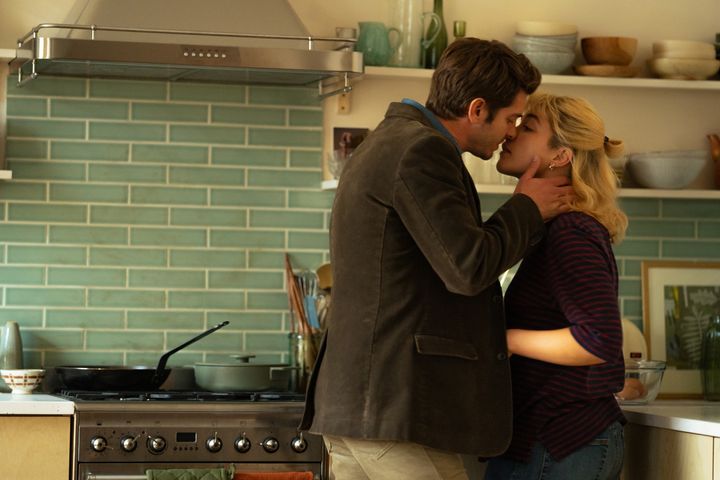It’s a tale as old as time: Two people meet, fall in love, and build a life together, warts and all.
It’s also a tale as old as time that how someone chooses to tell a story matters, sometimes just as much as what the story is.
The central conceit of “We Live in Time” is that the romance between its central characters, Tobias (Andrew Garfield) and Almut (Florence Pugh), is told nonlinearly. We get dropped into various periods of their relationship, like flipping through a stack of assorted snapshots of their lives.
If only that intricate and itinerant structure made a difference in the emotional experience of the film. Using a novel storytelling approach in an otherwise conventional relationship drama only works if it adds something to the story. That creative decision has to mean something, especially when the whole film, directed by John Crowley and written by Nick Payne, is predicated on that choice.
But in “We Live in Time,” an otherwise interesting storytelling choice ends up being a colossal waste of time. All of this — for what?
From scene to scene, it’s easy enough to figure out where we are in the progression of the couple’s relationship, based on dialogue and context clues. In its opening act, the film establishes some mile markers, like Almut about to give birth, or finding out she has an aggressive form of cancer, or what you eventually realize is the couple’s meet-cute. From there, viewers can generally piece together the order.
Unfortunately, it’s hard to argue that the film’s nonlinear structure changes the overall effect of watching it. Once you put the pieces together, there’s no “a-ha!” moment or emotional payoff.
It’s not like seeing the relationship out of order adds an extra significance to certain scenes, or makes you see an earlier development in a different light later in the film. Sometimes, films and television shows with a nonlinear structure might return us to a scene we saw earlier. Now that we’ve seen it again, having learned the context behind it, we understand it differently, or it may take on a greater magnitude.
“We Live in Time” doesn’t do that either. It drops us in and out of various stages of Tobias and Almut’s life together, just for the sake of having a nonlinear structure to signify…something about time. It’s unclear exactly what. Is time the constant drumbeat of our lives? Are time and death the only certainties all of us face?
Support Free Journalism
Support HuffPost
Already contributed? Log in to hide these messages.
Spoiler alert: Once it becomes clear how it’s all going to end, the film adopts a mostly linear structure in its final act. It’s around that time when you realize: The entire film could have unfolded in chronological order — and it would have made no substantive difference.
That’s probably because the choice to tell the story out of order is just about the only interesting feature of “We Live in Time.” Everything else about it is a standard, middling relationship drama: two conventional leads in Garfield and Pugh, bucolic views of the English countryside and a cursory side plot involving Almut’s career as a former competitive figure skater turned Michelin-starred chef. It asserts some generic greeting card sentiments, like life’s too short, so we should maximize our time doing what we love with the people we love.
By not doing anything substantive with its central creative decision, the film seems to think it’s more interesting than it actually is. Same with the memes and behind-the-scenes tidbits about the film’s sex scenes (which, contrary to what the online chatter would lead you to believe, are quite tame). Instead of enhancing the story, the nonlinear structure only exposes the film’s flimsy foundation.
If you’re not going to tell a new story, it makes sense to try to tell it in a new way. But if you’re going to tell it in a new way, make it count.
“We Live in Time” opens in limited theaters Friday, with a wider release on Oct. 18.
